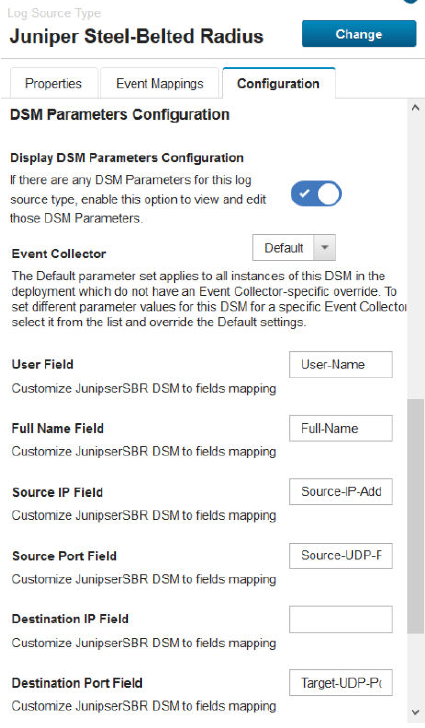- play_arrow Overview of JSA Administration
- play_arrow User Management
- play_arrow License Management
- play_arrow System Management
- System Management
- System Health Information
- JSA Component Types
- Data Nodes
- Network Interface Management
- JSA System Time
- NAT-Enabled Networks
- Off-site Hosts Management
- Managed Hosts
- Configuration Changes in your JSA Environment
- Deploying Changes
- Restarting the Event Collection Service
- Shutting Down a System
- Restarting a System
- Collecting Log Files
- Changing the Root Password on Your JSA Console
- Resetting SIM
- play_arrow JSA Set Up Tasks
- JSA Set Up Tasks
- Network Hierarchy
- Automatic Updates
- Manual Updates
- Configuring System settings
- IF-MAP Server Certificates
- SSL Certificates
- IPv6 Addressing in JSA Deployments
- Advanced Iptables Rules Examples
- Data Retention
- System Notifications
- Custom Offense Close Reasons
- Configuring a Custom Asset Property
- Index Management
- Restrictions to Prevent Resource-intensive Searches
- App Hosts
- Checking the Integrity Of Event and Flow Logs
- Adding Custom Actions
- Managing Aggregated Data Views
- Accessing a GLOBALVIEW Database
- play_arrow Event Data Processing in JSA
- Event Data Processing in JSA
- DSM Editor Overview
- Properties in the DSM Editor
- Property Configuration in the DSM Editor
- Opening the DSM Editor
- Configuring a Log Source Type
- Configuring Property Autodetection for Log Source Types
- Configuring Log Source Autodetection for Log Source Types
- Configuring DSM Parameters for Log Source Types
- Custom Log Source Types
- Custom Property Definitions in the DSM Editor
- Event Mapping
- Exporting Contents from the DSM Editor
- play_arrow Using Reference Data in JSA
- play_arrow User Information Source Configuration
- play_arrow Juniper Networks X-Force Integration
- play_arrow Managing Authorized Services
- play_arrow Backup and Recovery
- play_arrow Flow Sources Management
- play_arrow Remote Networks and Services Configuration
- play_arrow Server Discovery
- play_arrow Domain Segmentation
- play_arrow Multitenant Management
- Multitenant Management
- User Roles in a Multitenant Environment
- Domains and Log Sources in Multitenant Environments
- Provisioning a New Tenant
- Monitoring License Usage in Multitenant Deployments
- Rules Management in Multitenant Deployments
- Network Hierarchy Updates in a Multitenant Deployment
- Retention Policies for Tenants
- play_arrow Asset Management
- play_arrow Configuring JSA to Forward Data to Other Systems
- Forward Data to Other Systems
- Adding Forwarding Destinations
- Configuring Forwarding Profiles
- Configuring Routing Rules to Forward Data
- Using Custom Rules and Rule Responses to Forward Data
- Configuring Routing Rules to Use the JSA Data Store
- Viewing Forwarding Destinations
- Viewing and Managing Forwarding Destinations
- Viewing and Managing Routing Rules
- play_arrow Event Store and Forward
- play_arrow Security Content
- play_arrow SNMP Trap Configuration
- play_arrow Protect Sensitive Data
- play_arrow Log Files
- play_arrow Event Categories
- play_arrow Common Ports and Servers Used by JSA
- play_arrow RESTful API
New Features and Enhancements in JSA 7.4.0
The following new features and enhancements make it easier for administrators to manage their JSA 7.4.0 deployment.
To view a list of all new features in this release, see What’s New Guide.
Global System Notifications configuration
Global System Notifications are now local, making them host specific and more useful. As a result, the thresholds are now set automatically by JSA and the Global System Notification section of the Admin tab was removed.
Secure email server
Send email to distribute alerts, reports, notifications, and event messages to mail servers that require authentication.
You can configure an email server for your entire JSA deployment, or multiple email servers.
DSM Parameter support in the DSM Editor
In JSA 7.4.0, if your log source type has DSM parameters, you can use the DSM Editor to configure the DSM parameters. Enable the Display DSM Parameters Configuration option to view and edit the DSM parameters.

Reverse tunnel initiation
The SSH tunnel between two managed hosts can now be initiated from the remote host instead of the local host. For example, you have a connection from an Event Processor in a secure environment to an Event Collector that is outside of the secure environment. You also have a firewall rule that prevents you from having a host outside the secure environment connect to a host in the secure environment. In JSA 7.4.0, you can switch which host creates the tunnel so that the connection is established from the Event Processor by selecting the Remote Tunnel Initiation checkbox for the Event Collector.
Improved flow timestamp handling
Two new configuration settings provide more control over the way that flow timestamps are handled when Netflow V9 begins sending records with overflowed system uptime values. The new settings eliminate the need to reset the first and last switched times.
The new configuration options and the default values are shown here:
NORMALISE_OVERFLOWED_UPTIMES=YES
UPTIME_OVERFLOW_THRESHOLD_MSEC=86400000
The timestamps are corrected when the system uptime value is less than the first and last switched packet times by more than the value that is specified in the UPTIME_OVERFLOW_THRESHOLD_MSEC configuration. The timestamps are corrected based on the assumption that the system uptime wrapped around the maximum 32-bit value.





















